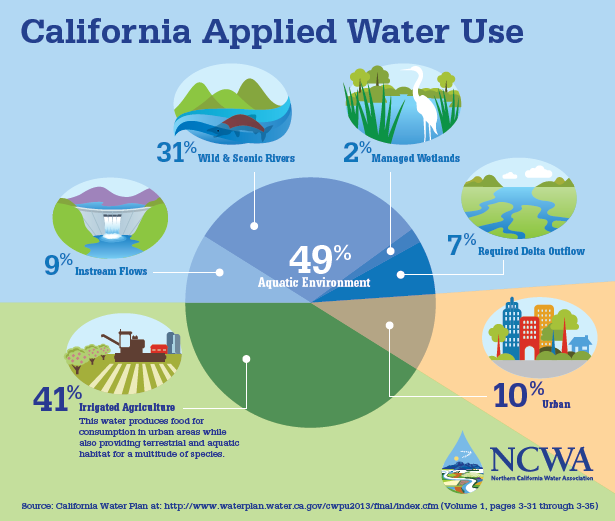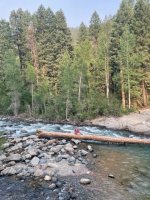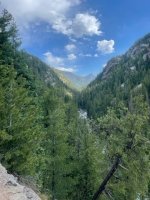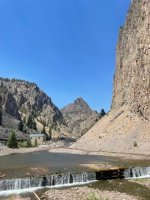J Alper
Site Sponsor
- Apr 30, 2021
- 2,042
- 1,766
This is two Weeks
Follow along with the video below to see how to install our site as a web app on your home screen.
Note: This feature may not be available in some browsers.
Actually put to use by man, sure, but they're excluding runoff into the ocean we don't even attempt to store or utilize:I thought this biggest consumption of the water was the farms, not houses? Regardless, I don’t know why they just don’t get started on the fix. There is ample water to solve the entire southwest region water needs by utilizing the Columbia River. The only real obstacle is that Siskiyou Montains. I don’t know why they can’t just use a TBM and run some tunnels to avoid having to pump the water over the top. There is enough water going out the Columbia to fill Shasta, Powell, Mead and more. Govt just needs to pull their heads out their a-holes and solve real problems. But if you take our water, you have to pay us back by taking our homeless too

With the rivers around me that are dry such as the santa ana and the Owens, I'd kinda like what we have left to stay the way they are. There used to be sturgeon in the Santa Ana river. Now, just a trickle.Actually put to use by man, sure, but they're excluding runoff into the ocean we don't even attempt to store or utilize:
Which is the majority of water use in California. Eventually, the grownups need to ask if leaving rivers completely wild all the way up into the mountains is worth continuing to ignore our water crisis.
Yep, me too. Only so much water though…With the rivers around me that are dry such as the santa ana and the Owens, I'd kinda like what we have left to stay the way they are. There used to be sturgeon in the Santa Ana river. Now, just a trickle.
We don't do that in Az. We build parks and golf courses in the wash's and riverbeds. In my area all of the storm water from my neighborhood gets pushed into the local park's lake. The overflow from that just sinks into the soccer field.I wonder how much of the groundwater problem is from all the concrete culverts we’ve installed…
One of my earliest memories with my Grandfather was driving up into the mountains near their house ( Duarte, Monrovia) to where they were building this big dam or expanding it I am not sure which. All I know is that is where we would sit and watch the Big Utes drive back and forth moving dirt.Local Reservoir, cool history. Used currently for Water Table resupply and runoff control :dunno:
https://en.wikipedia.org/wiki/Morris_Dam
The entire side of the mountain you could see from Duarte/Monrovia/Azusa is a nightmare now..One of my earliest memories with my Grandfather was driving up into the mountains near their house ( Duarte, Monrovia) to where they were building this big dam or expanding it I am not sure which. All I know is that is where we would sit and watch the Big Utes drive back and forth moving dirt.
How is the real impact, day-to-day, to me and millions of others, actual access to water out of our taps, not the real issue, to me and to the original author of this post and his question? I would argue that the subsidiary economic impacts to the average-joe resident in the West as a result of this issue is less impactful than mortgage interest rate increases or supply chain disruptions. So the “issues” all revolve around my actual access to water and AZ’s ability to continue to develop land and grow economically (AZ’ economy is largely based on this). With that said, there is absolutely a real surface-water scarcity issue within the CO river basin that will impact businesses and individuals in a non-uniform manner, I’m not denying that. All users of the CO River basin are going to be impacted, but not uniformly. The lion’s share of CO river users are agriculture based (although Ag also has the highest priority and will be impacted last). My understanding is that 80% of the CO River water used in the US is Ag and that 80% of that water is used for feed crops like alfalfa. My point in my original response was that as an AZ resident within an Active Management Area, we’re not going to have our potable/urban use wells run dry, which is how I read the original post question. The economic impact to agriculture will be lessened by water reducing practices such as drip irrigation and a switch to lower water using crops. Ag has got to get its chit together as it is a monster draw on a finite resource which they are WAY over using (not sustainable even in non-drought conditions). CA and AZ (to a much lesser extent) farming is a huge component of our Country’s food supply, but it can be done much more efficiently from a water use perspective and that resource is just one part of a global network of Ag resources that will naturally adjust as supply is constrained in one geographic region. Also - as pointed to in another post above, we need to stop allowing the exportation of pelletized alfalfa out of the Country. That’s a defacto exportation of water out of the Country and is being allowed to occur in AZ in non-Active Management Areas in a manner that is totally unregulated because of AZ’s oversized State Legislator influence from rural areas and the fact that Ag was hugely influential in the writing of State Law early in AZ’s existence as State. The unregulated pumping of ground water for inefficient flood irrigation alfalfa farming has to throttle down.@2442turborail in not even close to the issues, good read made me chuckle,
This is more than a 1 to 2 state issue,
When the water level gets to a point when the lake stops producing power and water for California crops, we are all going to pay for it, 2442 statement is like saying fuel prices will not efect the us, if Russia goes to war,
All of the western states are in this together, being taxes to pay for upgrades, hi power bill taxes or no water, all of the western states will feel this.
It’s interesting we’ve been staying, on and off, at Canyon RV park and for the last year and half they’ve been burying the Santa Ana river in a huge conduit. So it’s dry on top, but under is got to be flowing through the new tunnel….. curious what is the reasoning.With the rivers around me that are dry such as the santa ana and the Owens, I'd kinda like what we have left to stay the way they are. There used to be sturgeon in the Santa Ana river. Now, just a trickle.
I am not a water expert however I believe Az gets the 2nd largest share of the CO river but our state utilizes/has/refills our natural underground aquifers, I think we have near a 40/30/20/10 split between aquifers, CO river, in state rivers, and reclamation projects. So we could lose that CO river allotment (i think it was already cut for this year) and still "survive" but it will take cuts/caps on our usage and population growth.
This is one of the biggest problems we have water they just need to contain it. Ive been hearing this for the last few years about how much water just goes right back to the pacific. They need to work on an aquaduct system. How often do we here a state is in a drought and the state next to them has to much water. Goverment sucks and we just need to keep speaking up it is making a change and will get better if we stand together and let them know they work for us.We have had the wettest spring on record. Rivers are running at flood stage and it’s mid June. Mass amounts of water flowing out of the Columbia into the Pacific every day.
West of the continental divide had a terrible snow pack, idk about the east. But I just visited the Animas and backpacked Vallecito creek trail up to 92k no snow pack, rivers are bony (white water folks will know what i mean). I drove from phx passed though 6 rivers and double that amount of creeks all the way to Rio Grande in Creed and they are all low this year. The only good sign was that we did get some monsoon action in early June on our trip. I have been Kayaking and/or rafting the Animas and local lakes over the last 9+ years and the last good snow pack/high river action I remember seeing was in '18 maybe '19?Have also heard that with all the snow and rain in the north that the Colorado should have the best year in more than a decade



To your point I don't think the collapse of AZ and NV will be that it will look like MadMax and people will be killing people over a glass of water - at least before 2060 - its more of an economic collapse or at least a fight. California is the "breadbasket of America" and AZ has its agricultural base, and let's face it construction and housing is fueling the economy right now although I think "tech" has chance there.How is the real impact, day-to-day, to me and millions of others, actual access to water out of our taps, not the real issue, to me and to the original author of this post and his question? I would argue that the subsidiary economic impacts to the average-joe resident in the West as a result of this issue is less impactful than mortgage interest rate increases or supply chain disruptions. So the “issues” all revolve around my actual access to water and AZ’s ability to continue to develop land and grow economically (AZ’ economy is largely based on this). With that said, there is absolutely a real surface-water scarcity issue within the CO river basin that will impact businesses and individuals in a non-uniform manner, I’m not denying that. All users of the CO River basin are going to be impacted, but not uniformly. The lion’s share of CO river users are agriculture based (although Ag also has the highest priority and will be impacted last). My understanding is that 80% of the CO River water used in the US is Ag and that 80% of that water is used for feed crops like alfalfa. My point in my original response was that as an AZ resident within an Active Management Area, we’re not going to have our potable/urban use wells run dry, which is how I read the original post question. The economic impact to agriculture will be lessened by water reducing practices such as drip irrigation and a switch to lower water using crops. Ag has got to get its chit together as it is a monster draw on a finite resource which they are WAY over using (not sustainable even in non-drought conditions). CA and AZ (to a much lesser extent) farming is a huge component of our Country’s food supply, but it can be done much more efficiently from a water use perspective and that resource is just one part of a global network of Ag resources that will naturally adjust as supply is constrained in one geographic region. Also - as pointed to in another post above, we need to stop allowing the exportation of pelletized alfalfa out of the Country. That’s a defacto exportation of water out of the Country and is being allowed to occur in AZ in non-Active Management Areas in a manner that is totally unregulated because of AZ’s oversized State Legislator influence from rural areas and the fact that Ag was hugely influential in the writing of State Law early in AZ’s existence as State. The unregulated pumping of ground water for inefficient flood irrigation alfalfa farming has to throttle down.
Anyway, I think my position is well thought-through and well informed, as I’m in the subdivision development business and spend tens of thousands annually on water attorneys and other water resource consultants as it is an integral part of my business and as such I keep myself extremely well informed.

